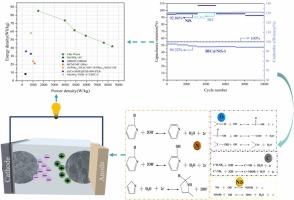Dual-base activation of Ipomoea Aquatica Stalk Biomass Carbon@NiS composites for high-performance supercapacitors
IF 6.3
2区 材料科学
Q2 CHEMISTRY, PHYSICAL
引用次数: 0
Abstract
Against the background of energy crisis and increasing environmental pollution, the development of efficient and reliable electrode materials for high-performance supercapacitors has become particularly urgent. In this work, naturally layered Ipomoea aquatica stalks (IA) were used as a carbon source and co-activated with NaOH/KOH to achieve self-templated conversion of biomass, producing biomass-derived carbon (BIC) with vertical “spine-like” channels. Subsequently, by precisely controlling the deposition amount and morphology of flower-like NiS nanocrystals on the BIC surface through the in situ hydrothermal method, a BIC@NiS composite material with a multi-level pore structure, close interface bonding, and optimized hydrophilicity was successfully constructed. BIC@NiS-1 as an electrode material exhibited excellent specific capacitance (1157.8 F/g at 1 A/g) and retained 94.32 % of the capacitance after 10,000 cycles at 10 A/g current density. The assembled BIC@NiS-1//BIC asymmetric supercapacitor achieved a high energy density of 85.12 Wh/kg and a cycling stability of 73.88 % (10,000 cycles) within a voltage window of 1.8 V. This study offers a promising approach for the high-value utilization of biomass waste and lays a solid foundation for the development of supercapacitor electrode materials with both high energy density and excellent stability.

用于高性能超级电容器的易拉木秸秆生物质Carbon@NiS复合材料的双碱活化
在能源危机和环境污染日益严重的背景下,开发高效可靠的高性能超级电容器电极材料显得尤为迫切。在本研究中,以天然分层的水草(iomoea aquatica)秸秆(IA)为碳源,与NaOH/KOH共活化,实现生物质的自模板转化,生产具有垂直“棘状”通道的生物质衍生碳(BIC)。随后,通过原位水热法精确控制花状NiS纳米晶在BIC表面的沉积量和形貌,成功构建了具有多级孔隙结构、界面键合紧密、优化亲水性的BIC@NiS复合材料。BIC@NiS-1电极材料表现出优异的比电容(1a /g时1157.8 F/g),在10a /g电流密度下循环10000次后仍保持94.32%的比电容。组装的BIC@NiS-1//BIC不对称超级电容器在1.8 V电压窗口内实现了85.12 Wh/kg的高能量密度和73.88%(10,000次循环)的循环稳定性。该研究为生物质废弃物的高价值利用提供了一条有希望的途径,为开发高能量密度和优异稳定性的超级电容器电极材料奠定了坚实的基础。
本文章由计算机程序翻译,如有差异,请以英文原文为准。
求助全文
约1分钟内获得全文
求助全文
来源期刊

Journal of Alloys and Compounds
工程技术-材料科学:综合
CiteScore
11.10
自引率
14.50%
发文量
5146
审稿时长
67 days
期刊介绍:
The Journal of Alloys and Compounds is intended to serve as an international medium for the publication of work on solid materials comprising compounds as well as alloys. Its great strength lies in the diversity of discipline which it encompasses, drawing together results from materials science, solid-state chemistry and physics.
 求助内容:
求助内容: 应助结果提醒方式:
应助结果提醒方式:


